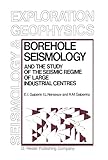Borehole seismology and the study of the seismic regime of large industrial centres [Libro electrónico] / E. I. Galperin, I. L. Nersesov, R. M. Galperina
Por: Galperin, E. I [autor/a].
Nersesov, I. L [autor/a] | Galperina, R. M [autor/a].
Tipo de material: Libro
en línea Series Editor: Dordrecht, Holland: D. Reidel Publishing Company, c1986Descripción: ix, 316 páginas : ilustraciones, mapa ; centímetros.ISBN: 9401085099; 9789401085090; 9789400945104 (Online).Nota de acceso: Disponible para usuarios de ECOSUR con su clave de acceso Nota de bibliografía: Incluye bibliografía: páginas 279-283 e índice: páginas 15-316 Número de sistema: 56845Resumen:
Libro
en línea Series Editor: Dordrecht, Holland: D. Reidel Publishing Company, c1986Descripción: ix, 316 páginas : ilustraciones, mapa ; centímetros.ISBN: 9401085099; 9789401085090; 9789400945104 (Online).Nota de acceso: Disponible para usuarios de ECOSUR con su clave de acceso Nota de bibliografía: Incluye bibliografía: páginas 279-283 e índice: páginas 15-316 Número de sistema: 56845Resumen:| Tipo de ítem | Biblioteca actual | Colección | Signatura | Estado | Fecha de vencimiento | Código de barras |
|---|---|---|---|---|---|---|
| Libros | Biblioteca Electrónica Recursos en línea (RE) | Acervo General | Recurso digital | ECO400568454838 |
Incluye bibliografía: páginas 279-283 e índice: páginas 15-316
Disponible para usuarios de ECOSUR con su clave de acceso
Advances in seismology and extensions of its application have made it increasingly necessary to perform high-sensitivity observationsonartificial earth tremors (explosions) or on natural ones. This implies in particular to investigating the seismic conditions in large industrial centres. There are many major cities with a million inhabitants or more in seismically-active regions. In the USSR, this applies to the capitals of the Union Republics such as Alma Ata, Frunze, Tashkent, Dushanbe, and Ashkhabad, as well as to dozens of local entres and cities with extensive industrial development. Seismic classification and earthquake forecasting have to be considered in relation to the extension or building of cities in such regions, and this would be impossible without detailed investigation of the seismicity, which involves upgrading the instru mental observation network. The demand for detailed information on the seismicity increases with every extension to the construction. A successful solution here can be implemented only by taking account of some specific factors, the main one being the high level of seismic noise due to the activities in large centres, which restricts the sensitivity of the apparatus and makes it impossible to record weak local earth tremors, which are of particular interest in periods of relative seismic calm. Stations at sufficiently great distances from the city do not sense the city noise, but they also fail to record weak local earth tremors. Also, the accuracy ofobservation falls for those tremors that can be recorded because of the great distances between stations. eng
Disponible en línea
Disponible en formato PDF
Subscripción a ELSEVIER 26 de diciembre del 2013
